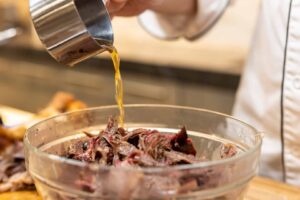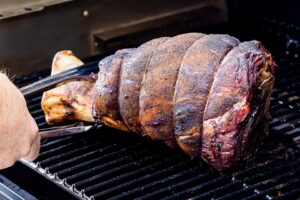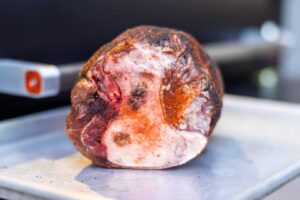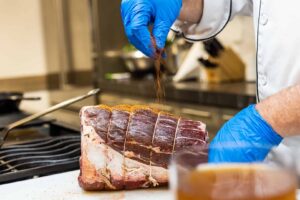On this January day, at ThermoWorks the weather makes you feel like staying indoors flipping through cookbooks and enjoying a meal. What’s the best way to spend such a day? Perhaps heading outside to smoke braise a beef shank!
Beef shank target temp: 203°F
This meal is perfect, for an evening. It’s flavorful tender and packed with goodness.. It requires an amount of time to prepare. Lets explore an approach (inspired by Jess Pryles) for smoking a complete beef shank along, with the essential temperatures to keep in mind.

What is beef shank?
Beef shank refers to the section of the beef leg. It is worth noting that shanks of veal, lamb or pork are also available and offer options.
Beef shank is an tasty meat cut, for ground beef. Today we’re focusing on preparing a shank with the bone intact which’s the best way to smoke this cut for maximum flavor. Smoking individual deboned muscles just doesn’t have the appeal. The large bone adds to the presentation of this cut making it a standout piece, for any occasion.

It may not be easy to find shanks at any grocery store meat counter, on any given day. It’s more common to come across shank slices often used for the delicious Italian dish Osso Bucco. While traditionally made with shank beef can be an alternative. The shank we managed to get was already prepared and tied an option if to you. There’s quite a bit of trimming involved when dealing with a shank so having someone else handle that step could lead to results. Opting for a shank, with skin removed, bone cut and tied back together is a smart choice. If your butcher can source a shank for you they might also assist in preparing it for cooking.
Why you should smoke-braise beef shank?
Smoke braising involves smoking a piece of meat to infuse it with flavor and then slow cooking it in an environment, with some liquid. This method is particularly important for cuts of meat, like shank, which comes from the leg of the beef. Shank contains a lot of tissue that needs to be broken down during cooking. With the braising process it can take around nine to ten hours for a beef shank to become tender. However the end result is rewarding as the meat transforms from tough and chewy to tender and flavorful releasing gelatin juices that enhance the braising liquid.
The meat may appear dry after shredding due, to its leanness. You can enhance its moisture by adding about a cup of the flavorful braising liquid. This will allow it to absorb and blend in well without becoming overly watery. The remaining juices can also be utilized for dipping sandwiches!
It’s totally fine if you decide to cook a shank;. In case you don’t own a smoker or simply prefer not to step outside to utilize one thats okay too. However the smoky essence combined with the beef flavor is truly delightful. The striking red smoke ring adds a touch that brings an appealing visual element to the meal.

Critical temps for smoke-braised beef shank
When making a dish that requires a cooking time, like this one you need to cook it at a temperature. In this case the smoker should be set to 275°F (135°C) throughout the cooking process. The shank is smoked for 2.5 hours before moving on to the braising step. After that transfer it to a foil pan and pour in a mixture of beef broth and light beer although you have the freedom to use any liquid of your choice.
When it comes to cooking times things get a bit tricky. The key is to let the collagen break down slowly and this breakdown depends on both temperature and duration. Aim for a range of 200–203°F (93–95°C). We removed ours at, around 200.7°F (93.7°C) after an hour of reaching that temperature from 200°F (93°C) ensuring time for the collagen to dissolve properly.
We relied on a Smoke® device to keep track of both the meat temperature and the smoker temperature, which turned out to be quite beneficial. Even though we were using a pellet smoker we still placed our air probe inside the pit. If we hadn’t set an alarm, for the air temp channel I probably wouldn’t have noticed that we had run out of pellets early in the cooking process. The combination of weather and a high pit temperature caused our pellets to deplete quicker than anticipated but thanks to the low temperature alarm on the Smoke X2 I was alerted to this issue. Given how cold it was during our cooking session we couldn’t afford any disruptions, in maintaining heat.
This recipe is definitely worth trying out. Beef shank can be quite affordable if you can source it and the end result is incredibly satisfying. You don’t have to limit this dish to the winter season; it’s just as delicious served in a burger style outdoors at a picnic table as it is enjoyed with mashed potatoes indoors to keep warm. Regardless of when you decide to cook it make sure you pay attention to those temperatures! Ensure that the meat reaches at 200°F (93°C) and that your smoker maintains a temperature of, around 275°F (135°C) throughout the cooking process—kudos to Smoke X2 for the tip! It may take some time from start to finish. Its an adventure worth embarking on even, during the winter months.

Recipe
Description
Smoke-braised whole beef shank, based on the method from Jess Pryles.
Ingredients
- 1 whole beef shank, trimmed, cut, and tied back on the bone
- BBQ rub of your choice
- 1 large onion, thinly sliced
- 4 cups of braising liquid (we used 2 cups beef broth and 2 cups beer)
- Salt for seasoning
Instructions
- Preheat your smoker to 275°F (135C).
- Season your shank well with your favorite BBQ rub.
- Place the shank in the smoker with the probe from your Smoke X2 placed in the thickest part of the meat.
- Set up the air probe in your smoker to monitor the temperature. Set the low-temp alarm to 250°F (121°C) and the high-temp alarm to 300°F (149°C).
- Smoke the shank for 2 1/2 hours.
- After 2 1/2 hours, move the shank to a foil roasting pan that barely fits it. Add the sliced onions and braising liquid.
- Re-insert the probe, cover the pan with foil, be sure the meat high-temp alarm is set to 200°F (93°C) and continue to smoke.
- When your alarm goes off make sure to verify the temperature and tenderness using your ®. The final stage of cooking might require up to a seven hours. Take your time. Ensure there is no pushback when inserting the Thermapen probe. Aim for tenderness!
- After checking if the meat is cooked well take it out of the smoker. Separate it from the cooking liquid, which would have increased in volume. Pull the meat apart into shreds. If it feels a bit dry add some of the cooking liquid to moisten it. Mix in some of the onions that cooked with the meat. Season, with salt if required.
- Serve how you see fit! Great as sandwiches or pot-roast style. Use the liquid for gravy or for dipping.
Note
- To save time, heat your braising liquid to nearly boiling right before adding it to the braising pan. Then you don’t have to bring it up to cooking temp in the smoker.
- In addition we opted for onions, in this recipe; however moving forward I would suggest caramelizing them. This technique brings it to the level of onion soup in terms of flavor complexity. Sauteing the onions would elevate it further. Enhance the richness of the dipping sauces.

I spent a good bit of my 20’s touring the country playing music. As a teenager, and throughout my 20’s, in between music, I always worked in restaurants, in various capacities. Somewhere in my late 20’s I realized that I was not on the cover of Rolling Stone, as planned, and so, I started thinking about my future and trying to figure out other ways to have an impact, be creative and still live a bit of that rock ‘n roll lifestyle. The restaurant industry provided me with a good bit of those things. And so, I started honing my chops in the kitchen, putting my nose in food lover’s companion, and really started to go somewhere with it.